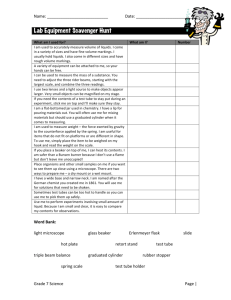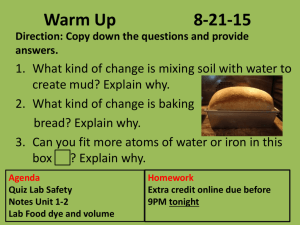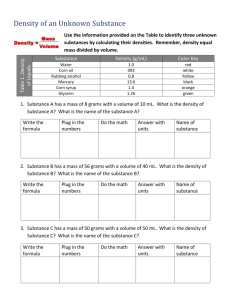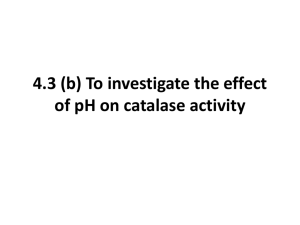Week 2 - Transfer and Measurement of Chemicals
advertisement
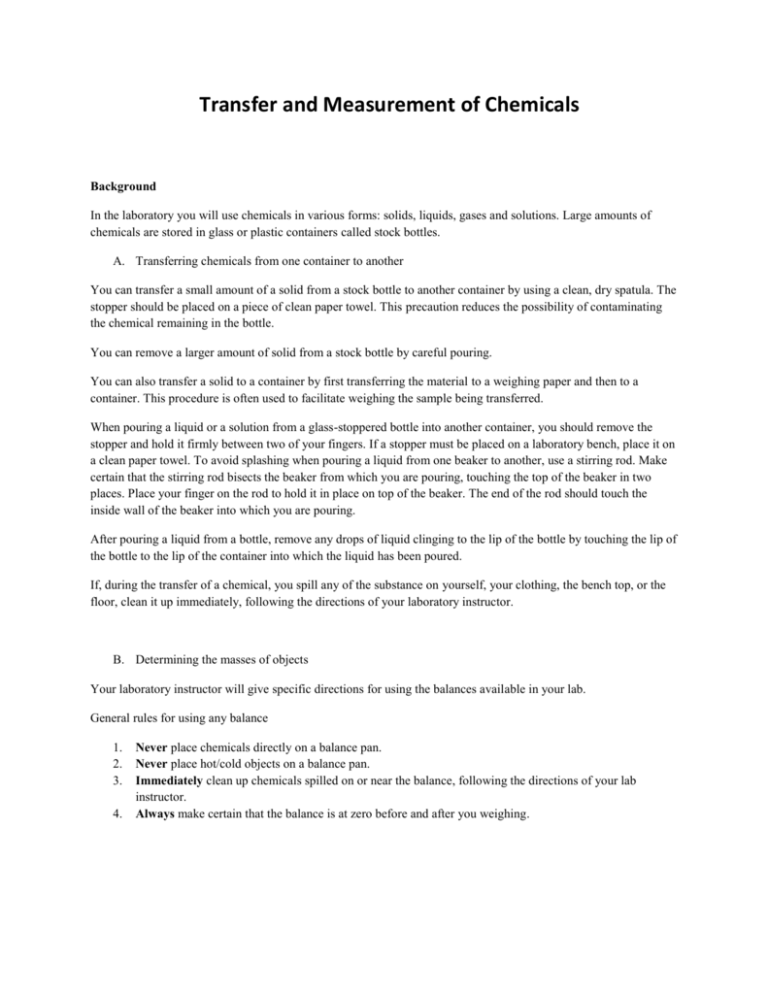
Transfer and Measurement of Chemicals Background In the laboratory you will use chemicals in various forms: solids, liquids, gases and solutions. Large amounts of chemicals are stored in glass or plastic containers called stock bottles. A. Transferring chemicals from one container to another You can transfer a small amount of a solid from a stock bottle to another container by using a clean, dry spatula. The stopper should be placed on a piece of clean paper towel. This precaution reduces the possibility of contaminating the chemical remaining in the bottle. You can remove a larger amount of solid from a stock bottle by careful pouring. You can also transfer a solid to a container by first transferring the material to a weighing paper and then to a container. This procedure is often used to facilitate weighing the sample being transferred. When pouring a liquid or a solution from a glass-stoppered bottle into another container, you should remove the stopper and hold it firmly between two of your fingers. If a stopper must be placed on a laboratory bench, place it on a clean paper towel. To avoid splashing when pouring a liquid from one beaker to another, use a stirring rod. Make certain that the stirring rod bisects the beaker from which you are pouring, touching the top of the beaker in two places. Place your finger on the rod to hold it in place on top of the beaker. The end of the rod should touch the inside wall of the beaker into which you are pouring. After pouring a liquid from a bottle, remove any drops of liquid clinging to the lip of the bottle by touching the lip of the bottle to the lip of the container into which the liquid has been poured. If, during the transfer of a chemical, you spill any of the substance on yourself, your clothing, the bench top, or the floor, clean it up immediately, following the directions of your laboratory instructor. B. Determining the masses of objects Your laboratory instructor will give specific directions for using the balances available in your lab. General rules for using any balance 1. 2. 3. 4. Never place chemicals directly on a balance pan. Never place hot/cold objects on a balance pan. Immediately clean up chemicals spilled on or near the balance, following the directions of your lab instructor. Always make certain that the balance is at zero before and after you weighing. C. Measuring the volumes of liquids The volumes of liquids and solutions are measured using graduated cylinders, burets and pipettes. Each of these pieces of glassware has etched lines, called calibration marks, on its surface. Each calibration mark corresponds to a specific volume of liquid. The accuracy and precision of volume measurements depends on the type and size of the glassware used. Measuring volumes using a graduated cylinder The graduated cylinder has numerical markings that identify the calibration lines. By determining the level of the liquid in the graduated cylinder with respect to these lines, you can determine the volume of the liquid. When measuring the volume, read the level of the liquid at the bottom of the meniscus. The meniscus is the curved surface at the top of a column of a liquid. Procedure A. Weighing the first object Choose a small object ( coin, key, 50 ml beaker…..) and following the directions given to you by the lab instructor determining the mass of it. B. Weighing the second object Choose another small object and following the directions given to you by the lab instructor determining the mass of it. C. Weighing the first and second object together Apply the same directions to find the mass of the two objects together. D. Measuring the volume of a container 1. Fill a 100-ml graduated cylinder with water. Use a dropper to add or remove water until the bottom of the meniscus exactly coincides with the 100- ml mark. Record this volume on your Data Sheet. 2. Transfer sufficient water from the cylinder to completely fill a clean, dry test tube. 3. Mark this test tube as #1. Read the volume of water remaining in the cylinder and record this second volume on your Data Sheet. E. Determining the number of drops in 1.0 ml of water 1. Pour around 5 ml of water from the graduated cylinder into a second clean, dry test tube. Read the volume of water remaining in the graduated cylinder and record it as the third volume. 2. Mark the height of water in test tube #2. Measure the height in millimeters and record it. 3. Empty the water from test tube #2 into the sink. Using a dropper, count the drops required to fill test tube #2 with water to the marked height. Record the # of drops required. 4. Pour around 5 ml of water from the graduated cylinder into a third clean, dry test tube. Measure the volume of water remaining in the graduated cylinder. Record this final volume. 5. Mark the level of water in test tube #3. Measure the height in millimeters. Record this height. 6. Empty the water from the test tube #3 into the sink. Using a dropper, count the drops required to fill test tube #3 with water to the marked height. Record the # of drops required. F. Converting grams to moles Why do we have to convert between grams and moles? When you go into chemistry lab, you measure out reactants and products in grams with a balance. We do not spend the day counting individual molecules until you have 6.023 1023 of them. Instead you go to a balance and weigh the mass of that compound. However when molecules react, they react at a molecular or molar basis, instead of a gram basis. So, we have to convert between grams and moles to match up what we can do experimentally in lab with what theory tells us is happening on a molecular scale. Moles can be calculated by dividing the mass (in grams) by the molar mass ( in g/mol). mol= m/MM If you were to weigh out 2 grams of NaCl, how many moles you’ll find? G. Converting milliliters to grams Many times in labs you know only the volume of a substance but not its mass. Having the density of that substance you can find its mass. The density is found by dividing the mass ( in g ) by its volume ( in ml ). d=m/V If you measured 57 ml of ethanol in a graduated cylinder ( with a density of 0.789 g/ml at 20 0C ) how many grams of it you will have? H. Measuring length With your meterstick or metric ruler measure the length and width or your lab handout. Take the measurements in inches ( to the nearest sixteenth of an inch ) and in centimeters ( to the nearest 0.5 cm ). Record your data. I. Measuring temperature With your thermometer measure the temperature of air in the lab, of boiling water and of ice water in degrees Celsius. ( to the nearest 0.1 0C ). Record your data. NAME: ___________________________ DATE: ______________ PARTNER: ________________________ SECTION: ___________ Transfer and measurement of chemicals Data Sheet A. Weighing the first object Object type _________________ Mass of object, g _____________ B. Weighing the second object Object type _________________ Mass of object, g _____________ C. Weighing the first and second object together Measured mass of 2 objects, g __________________ Calculated mass of 2 objects, g _________________ Difference between measured mass and calculated mass, g ________________ D. Measuring the volume of a container Initial volume of water in graduated cylinder, ml _________________ Second volume of water in graduated cylinder, ml ________________ Volume of test tube #1, ml _________________ E. Determining the number of drops in 1.0 ml of water Third volume of water in graduated cylinder, ml ________________ Height of water in test tube #2, mm ___________________ # drops H2O required to fill test tube #2 to marked height _________ volume of H2O in test tube #2, ml _______________ # drops H2O in 1.0 ml of H2O ( test tube #2 ) ____________ final volume of H2O in graduated cylinder, ml __________ height of water in test tube #3, mm _______________ # drops H2O required to fill test tube #3 to marked height _________ volume of H2O in test tube #3, ml _______________ # drops H2O in 1.0 ml of H2O ( test tube #3 ) ____________ Mean # drops of H2O in 1.0 ml of H2O ______________ F. Converting grams to moles 2 grams NaCl G. Converting milliliters to grams 57 ml ethanol __________ moles NaCl __________ grams ethanol H. Measuring Length handout length handout width I. ________________ in _________________ cm _________________ in _________________ cm Measuring Temperature air in the lab ____________ 0C boiling water ____________ 0C ice water _______________ 0C NAME: ___________________________ DATE: ______________ SECTION: ___________ Transfer and measurement of chemicals Post lab Questions 1) How many moles of copper atoms are in 150 g copper metal? 2) How many copper atoms are in this amount of copper? 3) Calculate the density in g/cm3 of Al if a 50 cm3 block weighs 135g ? 4) A bank received a yellow bar, marked gold, of mass 453.6 g and volume 23.5 cm3. Is it gold? ( Density of gold = 19.3 g/cm3 at 200C ) 5) Pike’s Peak in Colorado is the 32nd highest peak in the world and is 14,110 ft in height. Express this height in m. ( Hint: 1ft = 30.48 cm and 1m = 100 cm ) 6) Convert 37.0 0C in Fahrenheit and Kelvin degrees. ( Hint: Conversion in between these 3 scales is being done using the following equations: F = 9/5 * 0C + 32, C = 5/9(F-32), K = 0C + 273.15 )
